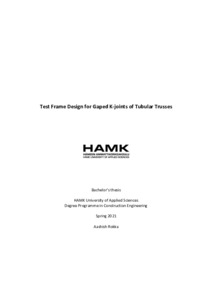Test Frame Design For Gaped K - joints of Tubular Trusses
Rokka, Aashish (2021)
Rokka, Aashish
2021
All rights reserved. This publication is copyrighted. You may download, display and print it for Your own personal use. Commercial use is prohibited.
Julkaisun pysyvä osoite on
https://urn.fi/URN:NBN:fi:amk-2021060714745
https://urn.fi/URN:NBN:fi:amk-2021060714745
Tiivistelmä
This research was conducted for HAMK Tech ̶, Research Unit of Häme University of Applied Sciences, to study the behaviour of welded tubular truss joints of high strength steel (HSS). The main purpose of this bachelor’s thesis was to set up K-joint test arrangement of truss in laboratory by modifying existing reaction frame from HAMK Tech. According to the joint classification of truss structures, each braces of a K joint is subject to either tension or compression force. On that account, for testing of K joint in the lab, three to four loading devices are needed to apply load on a K joint to creates tenson and compression force to the members. But, due to lack of sufficient loading device in HAMK Tech lab, two load actuators with 630 kilonewtons were available to generate required tension and compression force to the members. First, rigid curved support beam is designed for two bracing members to generate equal amount of tension and compression forces. Second step is to build the BIM model of steel frame using Tekla structures. In addition, structural analysis of steel frame was done according to elastic design in Dlubal RFEM. Finally, structural drawings such as general arrangement drawings and workshop drawings were created for manufacture and assembly of reaction frame component. As a result, this report shows the BIM integrated workflow between Tekla structures and Dlubal RFEM programme. Furthermore, this thesis highlights the use of Finite element design software and BIM software into design and analysis of the structure. Detailed representation of research task for K joint test arrangement including 3D modelling and structural analysis of steel reaction frame were presented in this thesis report. Structural calculation and design were based on Eurocode and K joint test project requirements.
